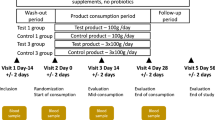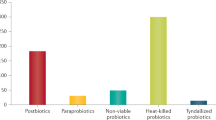Abstract
Objective:
In this study, heat-killed Lactobacillus johnsonii (La1), doubly labelled with 13C and 15N (hk-dlLa1), was used to follow the metabolic fate after oral administration in humans.
Design:
Experimental study.
Setting:
University of Rostock, Children's Hospital, Research Laboratory.
Subjects:
Ten healthy adults aged 23–26 years.
Intervention:
The subjects received 74.6 mg/kg body weight hk-dlLa1 and 10 g α-D-raffinose together with breakfast. A sample of venous blood was taken after 2 h. Expired air samples were taken over 14 h, whereas urine and faeces were collected over a period of 48 h. 13C- and 15N-enrichments were measured by isotope ratio mass spectrometry. Hydrogen concentrations were measured by electrochemical detection.
Results:
The orocaecal transit time (OCTT) was reached after 3.4 h. After 2 h, 13C- and 15N-enrichment of fibrinogen amounted to 2 and 25 p.p.m. excess, respectively. The 13CO2-exhalation amounted to 9.2% of the ingested dose. The urinary excretion of 13C and 15N was 2.1 and 10.4% of the ingested dose, respectively, whereas the faecal excretion was 47.9 and 43.7% of the ingested dose, respectively.
Conclusions:
In comparison to OCTT of 3.4 h, both stable isotopes appear after 30 min in breath and urine, indicating that hk-dlLa1 is rapidly digested in the small bowel before reaching the caecum. This is confirmed by 13C-and 15N-enrichments of blood plasma fractions. The ingestion of hk-dlLa1 led to a 13C- and 15N-excretion of 59.2 and 54.1% of the ingested dose, respectively, of both stable isotopes.
This is a preview of subscription content, access via your institution
Access options
Subscribe to this journal
Receive 12 print issues and online access
$259.00 per year
only $21.58 per issue
Buy this article
- Purchase on Springer Link
- Instant access to full article PDF
Prices may be subject to local taxes which are calculated during checkout




Similar content being viewed by others
References
Barrie A, Davies JE, Park AJ, Workmann CT (1989). Continuous-flow stable isotope analysis for biologists. Spectroscopy 4, 42–52.
Bernet MF, Brassat D, Neeser JR, Serving AL (1994). Lactobacillus acidophilus la1 binds to cultured human intestinal cell lines and inhibits cell attachment and cell invasion by enterovirulent bacteria. Gut 35, 483–489.
Brösicke H (1987). Bestimmung der Fettsäureoxidation Frühgeborener mit dem 13CO2 Atemtest während kontinuierlicher 13C-Triolein-Infusion. In: Ahnefeld FW, Hartig W, Holm E, Kleinberger G (eds). Klinische Ernährung. Zuckschwerdt: München, Bern, Wien, San Francisco, pp 4–17.
Cruchet S, Obregon MC, Salazar G, Diaz E, Gotteland M (2003). Effect of the ingestion of a dietary product containing Lactobacillus johnsonii la1 on Helicobacter pylori colonization in children. Nutrition 19, 716–721.
DeMan JD, Rogosa M, Sharpe ME (1960). A medium for the cultivation of lactobacilli. J Appl Bacteriol 23, 130–135.
Faust H, Bornhak H, Hirschberg K, Jung K, Junghans P, Krumbiegel P et al. (1981). Klinisch-chemische und isotopenanalytische Methoden zur Untersuchung des Stickstoff-Stoffwechsels mit N-15 beim Menschen. In: Wetzel K (ed). Methodenkatalog. ZfI-Mitteilungen. vol. 36 Akademie der Wissenschaften: Leipzig, pp 115–132.
Finegold SM, Sutter VL, Mathisen GE (1983). Normal indigenous intestinal flora. In: Hentges DJ (ed). Human Intestinal Flora in Health and Disease. Academic Press: New York, pp 3–31.
Fuller R (1989). Probiotics in man and animals. J Appl Bacteriol 66, 365–378.
Haycock GB, Schwartz GJ, Wisotzki DH (1978). Geometric method for measuring body surface area: a hight-weight formula validated in infants, children and adults. J Pediatr 93, 62–66.
Heine W, Mohr C, Münch C (1986). Zuckerverbindungen als Substrate für Wasserstoff- Atemgasteste: Korrelation zur Dosis, orozökalen Transitzeit, Mikroflora und zu Nebenwirkungen. Pädiatr Grenzgeb 34, 481–490.
Kandler O, Weiss N (1986). Genus Lactobacillus. In: Sneath PHA, Mair NS, Sharpe ME, Holt JG (eds). Bergey's Manual of Systematic Bacteriology. vol. 2. Williams & Wilkins: Baltimore, pp 1063–1065.
Kimoto H, Nomura M, Kobayashi M, Mizumachi K, Okamoto T (2003). Survival of lactococci during passage through mouse digestive tract. Can J Microbiol 49, 707–711.
Lee YK, Salminen S (1995). The coming age of probiotics. Trends Food Sci Technol 6, 241–245.
Leitzmann P, Heine W, Wutzke KD, von Bismarck P, Dorlöchter L, Miera O et al. (1998). Blood glucose, gastric emptying, and oro-coecal transit time after a conventional breakfast vs a Kollath breakfast. Z Ernährungswiss 37, 31–37.
Meydani SN, Ha WK (2000). Immunologic effects of yogurt. Am J Clin Nutr 71, 861–872.
Pfeiffer A, Rosat JP (1999). Probiotics in alimentation: clinical evidence for their enhancement of the natural immunity of the gut. In: Hanson LA, Yolken RH (eds). Probiotics, Other Nutritional Factors and Intestinal Microflora. Nestlé nutrition workshop series. vol. 42. Lippincott – Raven: Philadelphia. pp 243–255.
Radke M, Heine W, Wutzke KD, Leitzmann P, Walther F (1995). Tracer kinetic studies on a methionine-supplemented soy-based infant formula using 1-13C- and 15N-methionine as tracers. J Pediatr Gastroenterol Nutr 21, 209–214.
Robins-Browne RM, Levine MM (1981). The fate of ingested lactobacilli in the proximal small intestine. Am J Clin Nutr 34, 514–519.
Schoeller DA, Klein PD, Watkins JB, Heim T, MacLean Jr WC (1980). 13C abundances of nutrients and the effect of variations in 13C isotopic abundances of test meals formulated for 13CO2 breath tests. Am J Clin Nutr 33, 2375–2385.
Simakachorn N, Pichaipat V, Rithipornpaisarn P, Kongkaew C, Tongpradit P, Varavithya W (2000). Clinical evaluation of the addition of lyophilized, heat-killed Lactobacillus acidophilus LB to oral rehydration therapy in the treatment of acute diarrhea in children. J Pediatr Gastroenterol Nutr 30, 68–72.
Slater C, Preston T, Weaver LT (2001). Stable isotopes and the international system of units. Rapid Commun Mass Spectrom 15, 1270–1273.
Vantrappen GR, Rutgeerts PJ, Ghoos YF, Hiele MI (1989). Mixed triglyceride breath test: a noninvasive test of pancreatic lipase activity in the duodenum. Gastroenterology 96, 1126–1134.
Wutzke KD, Heine W, Drescher U, Richter I, Plath C (1983). 15N-labelled yeast protein – a valid tracer for calculating whole-body protein parameters in infants: a comparison between [15N]-yeast protein and [15N]-glycine. Hum Nutr Clin Nutr 37C, 317–327.
Wutzke KD, Heine W, Völker T, Kreyenbrink F, Krawielitzki K (1984). Präparative Darstellung von Hochangereichertem 15N-markiertem Hefeprotein. Isotopenpraxis 20, 90–93.
Wutzke KD, Oetjens I (2005). 13C- and 15N-incorporation of doubly stable isotope labelled Lactobacillus johnsonii in humans. Eur J Clin Nutr 59, 1167–1172.
Wutzke KD, Sattinger V (2006). 15N-excretion of heat-killed Lactobacillus casei in humans. Eur J Clin Nutr 60, 847–852.
Xiao SD, Zhang de Z, Lu H, Jiang SH, Liu HY, Wang GS et al. (2003). Multicenter, randomized, controlled trial of heat-killed Lactobacillus acidophilus LB in patients with chronic diarrhea. Adv Ther 20, 253–260.
Acknowledgements
We thank Professor em. Willi Heine, MD, PhD; Dr Christa Mohr, Peter Leitzmann, MD; Hannelore Kusak and Renate Froh for their assistance.
Author information
Authors and Affiliations
Corresponding author
Additional information
Guarantors: KD Wutzke and D Haffner.
Contributors: DB was principal investigator and doctoral candidate of KDW.
Rights and permissions
About this article
Cite this article
Wutzke, K., Berg, D. & Haffner, D. The metabolic fate of doubly stable isotope labelled heat-killed Lactobacillus johnsonii in humans. Eur J Clin Nutr 62, 197–202 (2008). https://doi.org/10.1038/sj.ejcn.1602716
Received:
Revised:
Accepted:
Published:
Issue Date:
DOI: https://doi.org/10.1038/sj.ejcn.1602716



